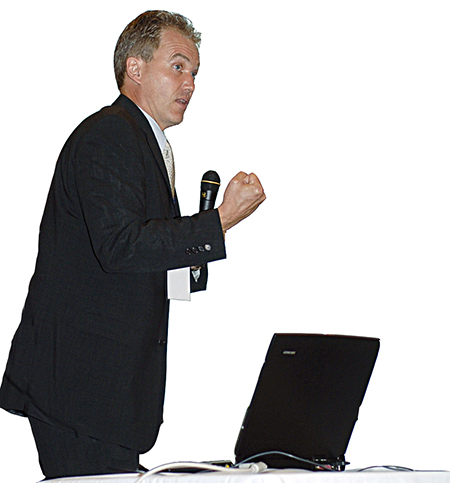 Gerd Heuschmann is a unique combination – an equine vet who actually rides. Trained as a professional rider before going on to undertake his veterinary studies, Gerd conducts a practice near Warendorf, Germany, and also lectures the professional riders who study there. Last year, Gerd was a featured speaker at the FEI Dressage Seminar and his scheduled talk was such a hit, that the audience demanded that he come back later in the day and give another talk. So here it is…
Gerd Heuschmann is a unique combination – an equine vet who actually rides. Trained as a professional rider before going on to undertake his veterinary studies, Gerd conducts a practice near Warendorf, Germany, and also lectures the professional riders who study there. Last year, Gerd was a featured speaker at the FEI Dressage Seminar and his scheduled talk was such a hit, that the audience demanded that he come back later in the day and give another talk. So here it is…
In this instance, I want to look at the joint – I could take the lung or I could take the heart and make the same point, but a joint works very well to illustrate what I want to say.
What do we need to have in a joint? We need at least two bones. We need a joint capsule, we need the cartilage and we need the fluid inside. So here is my question – how do the cells within the joint get their nutrition?
The blood?
But there are some tissues in the body which have no direct blood supply – in this case, the cartilage, and it is also the case in the tendon tissue. As many of you know, if you take a small piece of cartilage and put it under the microscope, you will see many big round cells. Living cells that have to deal with the stress that we place on our sporthorses. And the horses with the lowest level of stress, the dressage horses, are where we have the biggest problems.
Where does the cartilage get its food from? There are only two possibilities. The first is that it is transported through the bone, or the other possibility is the synovial fluid. Now we have the interesting question – how do you get anything into this hard, smooth, elastic tissue? It is the so-called ‘swamp’ principle. When you have the weight bearing phase in the movement of the horse’s leg, the cartilage is pushed together, the waste is pushed out, when you have a loose horse, and the swinging phase, this creates a vacuum in the joint, and the cartilage sucks in the nutrient.
Let’s think about the Zebra walking 19 hours a day. The joint nutrition is perfect, pressing out, sucking in, pressing out. This is how the cartilage lives. Now think about a horse in Europe, twenty three and a half hours in the stable. This is what makes the veterinarians wealthy!
The story continues below the advertisement
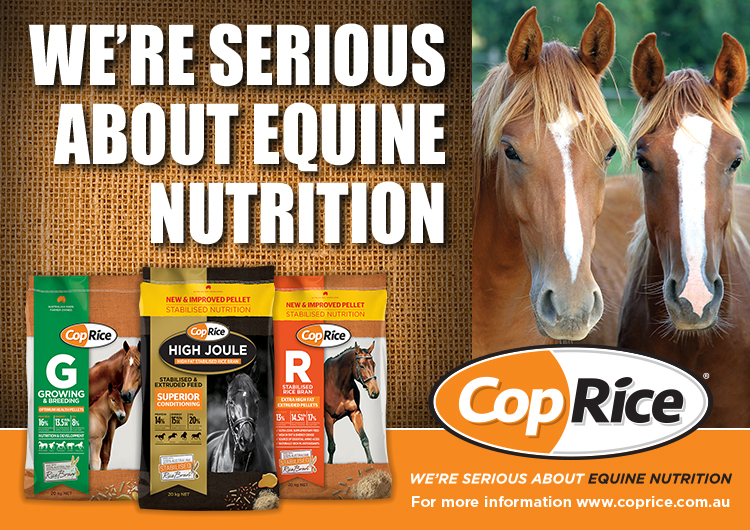
The horse is built to move. It was interesting the dressage trainer, Jean Bemelmans says he takes his horses out at least three or four times a day, that the horses move their bodies at least four hours a day.
As vets, we earn most of our money from bad riding and from horses being kept in the stable.
What is the first sign for the rider or the trainer, that there is something wrong with the cartilage in the joint? What would you do, if you were the cartilage and you recognized that the nutrition level is too low – it doesn’t get enough to eat? Increase the pressure in the joint – and then you get wind galls.
Suddenly our wonderful dressage horse gets wind galls. If you ask the young professional riders where the windgalls come from, they have crazy ideas, diet, whatever. But they come from a lack of movement, they come because horses spend too many hours in the stables.
Make the veterinarians poor – take the horses out of the stables!
Now let us look at the toe of the horse. Most people know about the bony structure of the hoof, the cannon bone, first, second and third phalanx, the navicular, and the sesamoid bones in the fetlock area. Then we have to look at the apparatus that is carrying the fetlock, divided into the suspensory which is fixed at the cannon bone and fixed at the sesamoids, and the distal ligaments. This system supports the fetlocks, if you cut it, it all falls down – you sometimes see it with old broodmares when they sink down in the fetlocks and the hock is straight and the stifle is straighter.
Now we need to look at another system, the deep flexor tendon going around the sesamoids behind the fetlock, going down the navicular and it is fixed at the third phalanx.
Once we have an idea of these systems then we can look at what seems to me a very big problem with our sport horses in Germany – and that is how they are shod.
First another question. How do we want to divide the horse’s weight? Evenly. What do we need to have the weight distributed evenly? Flat even feet. When the horse walks, the foot has to hit the ground with the toe and the heel at exactly the same moment so the weight is distributed evenly.
What happens when you start to alter that balance. Many farriers do orthopaedic shoeing without knowing that is what they are doing, because they don’t look, they don’t care. Without thinking, our farriers cut the heels and make the foot very flat – what happens to the deep flexor? There is more pressure on the navicular, the deep flexor gets more stressed, there is more pressure and the fetlock is pushed forward, and the suspensory becomes loose.
more follows
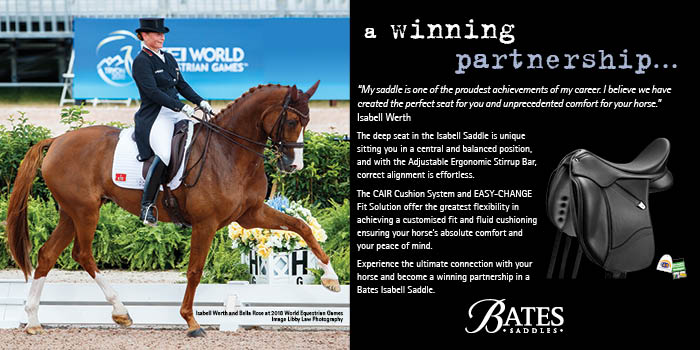
But more often the farriers in Europe raise the heels. So the deep flexor is without tension, the navicular has no pressure, the whole tendon is rather loose, and all the weight is on the suspensory. Many people accept that the farrier takes the horse out of the stable, takes off the shoes, cuts the hoof, puts on new shoes and goes home again. He didn’t look for one second how the horse sets down its foot. It is so important if you have a healthy horse to have the weight evenly distributed through all the structures, and that is only possible when you see how the horse moves.
If you have a horse with suspensory problems, it doesn’t help to raise the heels. Sometimes you find veterinarians who recommend that you raise the heels for a suspensory problem, I don’t know why, but they do.
To understand the horse’s toe a bit more, let’s look at a longitudinal cut through the toe. In the hoof area you have a small capsule. The hoof looks different to the hoof in a living horse – you see there are many things inside. The phalanx, the navicular, the flexor tendon, the digital cushion. What is the function of the digital cushion? It is a pump that circulates the blood and this relates to the weight-bearing phase of the hoof action. For this you need a good digital cushion and you need a very well developed hoof.
Let me tell you a little story of how I started thinking about this… Because who is interested in the hoof? I wanted to concentrate on riding but I discovered that a mountain of problems came out of wrong hoof management, and it was so easy – nearly as easy as riding – to manage a good hoof. When you have every part of the hoof hitting the ground at the same time, then you get ideal pressure on the frog – and from the pressure on the frog you get the pressure on the digital cushion, it widens the hoof in the area of the heel and keeps the hoof healthy.
story continues below the advertisement
Many years ago I was at a veterinary congress in the United States, and an old farrier gave a paper on ‘Hoof Symmetry’. He had conducted a study on wild horses in the Rocky Mountains. In the autumn, they bring the horses down, they take the stallions out to be gelded, trained and sold, and the mares go back to the mountains.
The presentation started with a video which showed hundreds of horses coming down and they were galloping over fields of big stones, and after they had galloped over these stones, nothing happened, they were all sound. Then we were shown that they all had round, big hooves and they had very low heels. And I had never seen frogs like that before, very big frogs. Then I started to think – each tissue reacts to the influence from outside.
Things are changing a little in Germany now, but ten years ago, all our foals were born in our winter, snow, cold, wind, rain, so the baby foals live with their mother on a high soft bed of straw. They spend the first weeks, maybe months, in the stables like that. If they are lucky they are allowed to go out to the deep mud! If you go around in the Spring, then you see very good looking foals, strong with big muscles, wonderful necks standing on small, little hooves with high heels and the frog is practically invisible.
Think of the little navicular, how can you expect the small bones to develop if there is no pressure on this little navicular?
Okay we can’t change the conditions in our paddocks, but we can change what we do with our horses in the wintertime. Horses normally live on the plains. Look at the Zebra again, dry, hard ground. Our foals are born on the soft ground, then the soft mud, then the soft meadows with grass nearly one metre high. We feed them as if we want to eat them! They always look very good, we grow them up on soft ground – how can we expect them to be sound?
Take an x-ray of a three-year-old Warmblood horse out of this typical European production process, and you find a weak dark x-ray. Make the same picture from a three year old Thoroughbred in race-training, and use the same x-ray machine, same everything but what you see is totally different – you will see a white bone. The white bone has a lot of calcium. The wall of the bone in the Thoroughbred is twice as thick as the Warmblood’s bone.
If you don’t influence the skeleton of your growing horse with hard ground, uneven ground, if you don’t cut down the heels with your foals, if they don’t put the frog to the ground, you get a wonderful big mover with soft, ‘cheese’ legs. We forgot that the horse comes from the plains.
Especially in the dressage scene, think about the horse’s leg – and we find lovely soft leg bandages, and lovely soft ground to work on, especially the younger horses. But it should be exactly the other way. The younger horse’s leg can react to outside stimuli, the younger horse’s leg must feel the hard ground, every day if possible but at least three times a week. When you have finished your training session, give the horse the rein and go out on the road for a walk. Half an hour, up and down. Give the horse this hard ground and you will get strong hooves, good joints, strong tendons and a healthy horse. We have to train our horses on soft ground but we should not keep them on that soft ground all their lives.
After being a veterinarian for twenty years, I get the feeling that we are seeing more and more back problems, kissing spines, muscle problems and so on. Especially kissing spines. For a long time when I was training as a rider, I thought that it was the bad riders that caused the problem, especially the ones with the draw reins. Then I went to veterinary school and started doing my first vet checks, and I found three year old horses who had never had a rider, who came straight off the grass, and they had very severe kissing spines from the withers back to the sacrum. How can this be? It’s impossible.
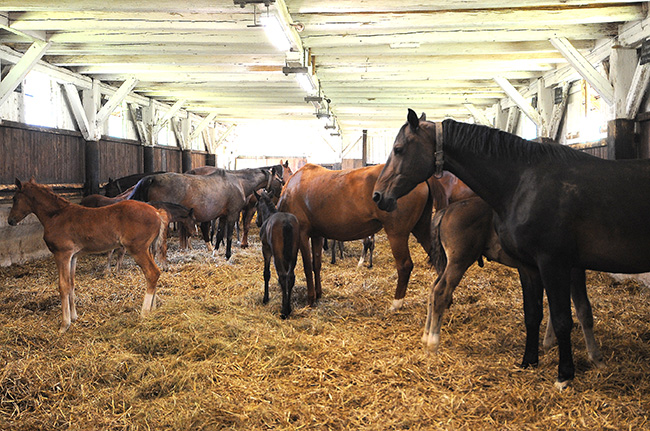
The baby foals live with their mother on a high soft bed of straw. They spend the first weeks, maybe months, in the stables like that. If they are lucky they are allowed to go out to the deep mud!
If you go around in the Spring, then you see very good looking foals, strong with big muscles, wonderful necks standing on small, little hooves with high heels and the frog is practically invisible.
Maybe it is the licensing commission, perhaps they are licensing the wrong stallions – perhaps it is a conformation problem. Then I thought, maybe it’s the breeders who are the bad boys – I really didn’t know.
Seven or eight years ago, I started giving functional anatomy classes in Warendorf for our young professional riders. I explained to them, forwards, downwards with the young horse, I explained what happened with the nuchal ligament to bring up the back and suddenly I started thinking, what happens to our young horses in the first three years?
We try to grow them up very intensively. I always compare it to the young zebra. The young zebra, if it wants to eat there is one bit of grass here, one bit of grass there, this means for hours and hours and hours, the young zebra has its mouth on the ground and the back up.
We fill our young horses with oats and we give them grass so high and so rich that when they put their head down for half an hour they have filled their stomach.
The time the young horse is grazing with its head on the ground in Europe is not enough to bring its back up to create a strong and functional back. Once again, this intensive horse rearing system for the first two years, brings us a lot of problems.
I think less is more. Here in Australia you have lots of desert, if you sent your young horses out there, then when they came back, if they came back, you can be sure the back is up.
The intensive feeding we practice to make them look good, as yearlings, two year olds, and especially as three year olds when we want to sell them, is not good. These heavy, over-developed two and a half year old stallions at the licensing, they eat 20 pounds of oats a day – they look nice, but they have back problems because they never had the chance to spend the day with their nose on the ground.
These are some ideas I have brought together to change your thinking.
When you buy a young dressage horse, a four year old, then good hoof management, good parasite management, exercising regularly on the hard ground, and try to ensure that that the horse has a healthy back, then you give him the best start you can…
And once again, the audience roared its enthusiasm for Gerd’s lecture.
Gerd is certainly an inspiring advocate of the classical principles – if you want more of his articles go to his Who’s Who entry
Want to breed to a top European dressage stallion this year? Choose from the extensive range available from International Horse Breeders: www.ihb.com.au
Interested in the new young star stallions? Why not try Vivino? A super young stallion by Vivaldi out of a Dancier dam. DETAILS



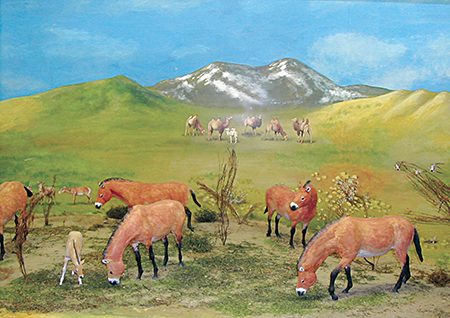
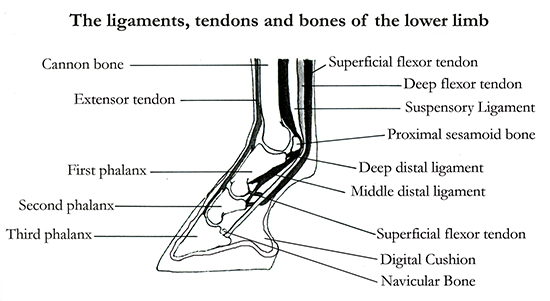
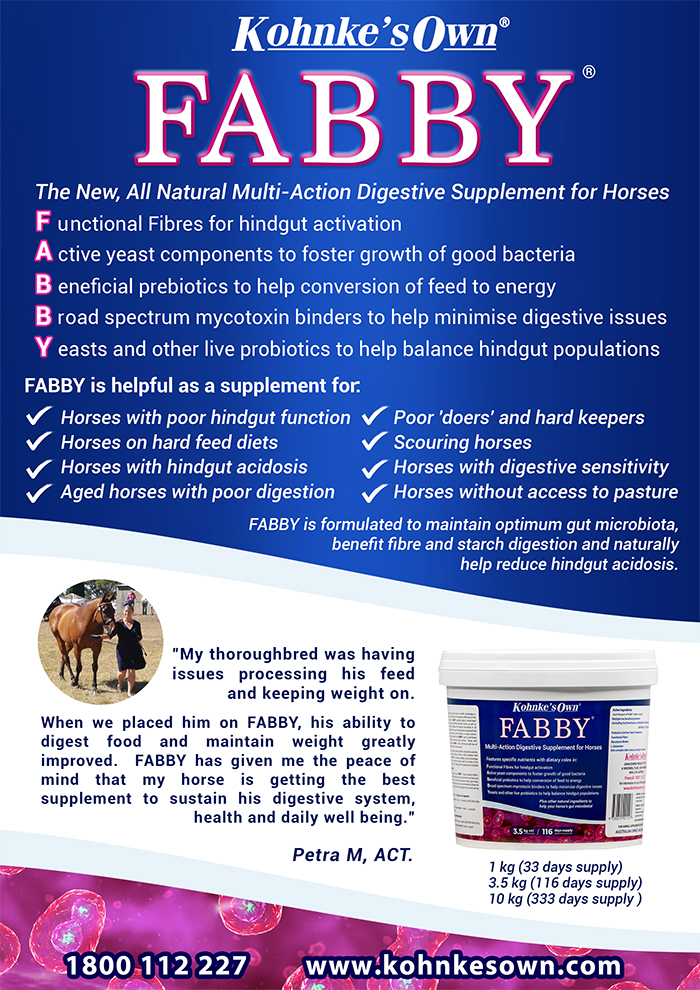
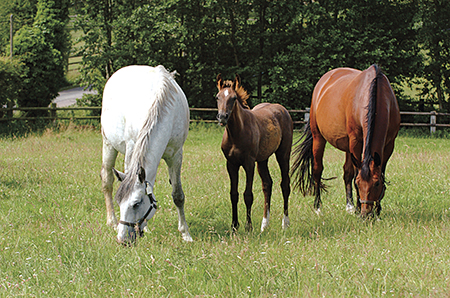

My sincere thanks Dr Heuschmann for bringing this very important issue to our attention. It is unfortunate that most people today are utterly ignorant of the laws of nature. If only we would observe nature more then we would have less problems of any kind in the world today. The Law of Nature provides the blueprint for everything to work to best practice. Nature provides a natural remedy for every natural problem that we might experience. Nature knows best is a slogan that I was brought up with, and by experience I have learnt this to be so. Today most follow whatever is promoted by those who work for profit. We have lost the power of natural reason and continuously follow without thinking. In so doing we unwittingly inflict all sorts of serious and permanent damage to our beloved horse. We ignore the natural growth phases of our young horses and turn them into geriatics before they turn six. Most are ignorant of the fact that the last growth plates, those in the back and neck, only set between the years 6-8. Anyone suffering from personal back problems will understand and appreciate how important it is to preserve the back and neck.
It is not unreasonable to suggest that breeders have a vested interest in pushing their young progeny to the limit for financial gain. Already for years warnings have been issued about pushing our young horses to early. Clearly they have fallen on deaf ears. Profits follow results, and our young horses are made to perform earlier and earlier to limits beyond their age. Also since owners and riders are no longer dependent on their horse they are no longer attuned to their horse as they otherwise would. The horse has become just another toy for personal entertainment. Not unlike a tennis racket or hockey stick, if it breaks [down] just buy another.
I urge all dressage riders to research the great riding masters of centuries ago and to take note that all without exception continuously advise to follow and mimick nature. For only nature provides for best practice and best results.
What a clever man!
One of the big problems in the warmbloodbreeding is the influcence of the Thorougbred. Oberlandstallmeister Dr. Gustav worote already in 1910 that this on the forehand built and moving racehorse has not the right skeleton for a sporthorse. For a sporthorse is “Das Gleichgewicht” crucial. If use the TB in the warmbloodbreeding the outage will be great and that is what we see nowadays. On top of that the TB has a nervous and sensible mind and that is also not suitabkle for a sporthorse.
Het vijfjarige onderzoek naar Vorkommen und Bedeutung von Rücknererkrankungen -ins besondere des “Kissing Spine”-Syndroms- (KSS) bei Pferden in Süddeutschland (1995-2000) van de Universiteit van Muenchen o.l.v. Prof. Dr. H. Gerards toonde o.a. het volgende aan:
Het vijfjarige onderzoek naar Vorkommen und Bedeutung von Rücknererkrankungen -ins besondere des “Kissing Spine”-Syndroms- (KSS) bei Pferden in Süddeutschland (1995-2000) van de Universiteit van Muenchen o.l.v. Prof. Dr. H. Gerards toonde o.a. het volgende aan:
Nachdem die Warmblütter die grösste Gruppe der untersuchten Rassen stellten, waren sie natürlich auch von KSS-Veränderungen am meisten betroffen. Die Anzahl der untersuchten Araber, Haflinger und Islaender ist zwar gering, doch scheinen diese Rassen selten unter einem KSS zu leiden und werden deswegen auch seltener wegen Rückenproblemen. vorgestellt. Auffällig ist jedoch, das 7 von 8 untersuchten Vollblütern und 4 von 8 Quarter Horses ein röntgenologisch KSS aufweisen
Brilliant piece. Nature as it should be. Sport and working horses kept close to what they are built for. Excellent and mostly common sense!
Dear Dr. Gerd: congratulations for your interesting work. I always tell to my clients and friends we need to learn from racing. They are the vangard and the most professional piece of the horse industry. Best regards, Jose A. Teomiro, vetwrinary surgeon.